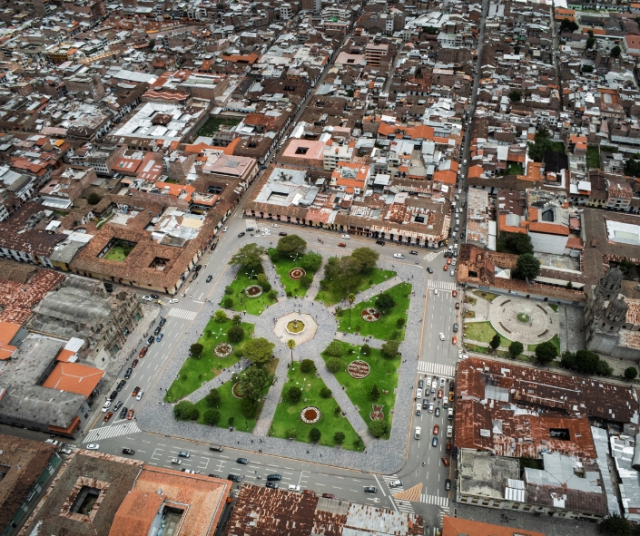The Cajamarca Carnival is one of the most notable and anticipated festivities in the northern region of Peru. With its roots deeply embedded in the area's history and culture, this annual event attracts visitors from across the country and abroad. Over the years, the Cajamarca Carnival has established itself as a vibrant manifestation of the region's cultural identity, with its parades, dances, music and, of course, the traditional and colorful water painting that characterizes this celebration.
History and Origins
The Cajamarca Carnival emerges from the depths of history, fusing pre-Inca, Inca and Spanish influences in a unique celebration that has withstood the passage of centuries. This colorful event, rooted in the northern region of Peru, has its foundations in the ancient practices of local communities, who celebrated the fertility of the land and expressed gratitude to the gods for abundant harvests in pre-Inca times.
With the arrival of the Incas, these festivities took on a new nuance, merging with the traditions of this powerful civilization. Cultural wealth multiplied, and Carnival became an even more diverse expression of local identity. However, the Spanish conquest not only introduced a new language and religion, but also influenced the festivities, fusing native customs with European elements.
Despite colonizing attempts to suppress some indigenous practices, many of them resisted and mixed with new customs, giving rise to a hybrid festival that became the Cajamarca Carnival. This annual event encapsulates the rich and complex history of the region, serving as a testament to the adaptability of local traditions through the centuries.
The celebration of the Cajamarca Carnival has been maintained over the years, transforming into a unique synthesis of indigenous and European heritage. It is a journey through time, where pre-Inca roots are intertwined with Inca traditions and Spanish influences, forming a cultural tapestry that defines the identity of the region.
Today, the Cajamarca Carnival is one of the largest and most colorful celebrations in the region. The festival generally begins in late February or early March, coinciding with the rainy period that characterizes this season in northern Peru. The exact duration may vary, but the intensity of the celebrations remains constant throughout the holiday.
Parades and Comparsas
One of the highlights of the Cajamarca Carnival are the parades and troupes that fill the streets of the city. These parades are a display of creativity and talent, as participants of all ages dress in colorful costumes and perform traditional dances to the rhythm of festive music. Troupes often represent different aspects of local culture, from historical figures to mythical figures and deities.
The dances are accompanied by live music, usually performed by local bands playing traditional instruments. The parades are a manifestation of the cultural richness of the region, and participants spend weeks and even months preparing their costumes and choreography to ensure that every detail is perfectly executed.
Water Painting: Tradition and Fun
One of the most emblematic traditions of the Cajamarca Carnival is water painting. During the holiday, people take to the streets armed with water guns and buckets filled with water colored with non-toxic dyes. This tradition has its roots in the ancient practice of throwing water on others as a form of purification and fertility. Over the years, the simple action of throwing water has evolved into a friendly competition, where friends and strangers throw water at each other, creating an atmosphere of fun and camaraderie.
Water paints are also used to embellish the costumes of the participants in the parades. The vibrant colors create a stunning visual spectacle, and the combination of music, dance and water painting brings the streets of Cajamarca to life in a unique and exciting way.
Gastronomy and Culminant Traditions
The Cajamarca Carnival is not only a celebration for the senses, but also for the palate. During this festival, you can enjoy a variety of traditional dishes that are emblematic of the region. Gastronomy plays a crucial role in Carnival's identity, and local dishes are offered in abundance in markets and street stalls.
Dishes such as guinea pig, stuffed rocoto and mazamorra morada are just some examples of the delicious culinary offering that can be enjoyed during the Cajamarca Carnival. These foods are not only delicious, but also represent the rich culinary tradition of the region.
The culmination of the festivities often includes special events, such as costume contests, election of Carnival queens, and the burning of the "Ño Carnavalón", a representative doll that symbolizes the end of the festivity and preparation for the following year.
Cultural and Tourist Impact
The Cajamarca Carnival is not only a local celebration, but has also gained national and international recognition. The holiday attracts tourists from all over the world who seek to experience the cultural richness and contagious joy of this unique event.
Tourism during the Cajamarca Carnival not only benefits the local economy, but also contributes to the preservation of the traditions and customs of the region. The interaction between visitors and the local community creates an enriching cultural exchange that strengthens ties between people and promotes mutual understanding.
Globalization, climate change and other external factors have influenced the way Carnival is celebrated. Local communities have had to adapt to these circumstances, seeking ways to preserve the essence of the holiday while facing new challenges.
Technology has also played a role in the evolution of Carnival. The spread of images and videos through social media has allowed the holiday to reach wider audiences, but at the same time raises questions about authenticity and the preservation of traditions in an increasingly digital world.
Despite these challenges, the Cajamarca community has demonstrated remarkable resilience and determination to preserve and enrich its cultural heritage through Carnival. The holiday continues to be a living testimony to the adaptability of local traditions in a constantly changing world.
